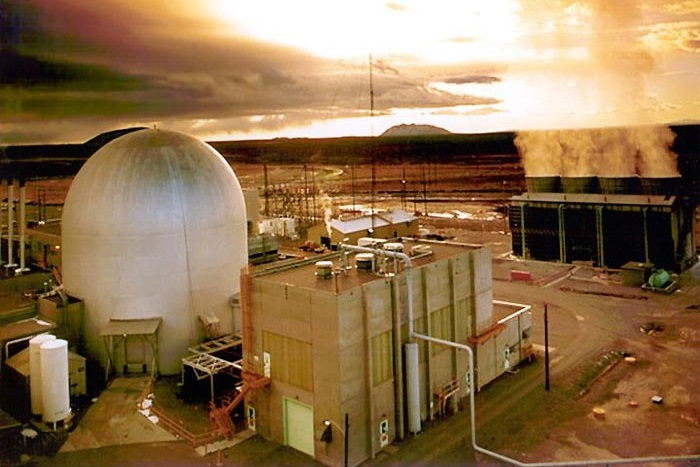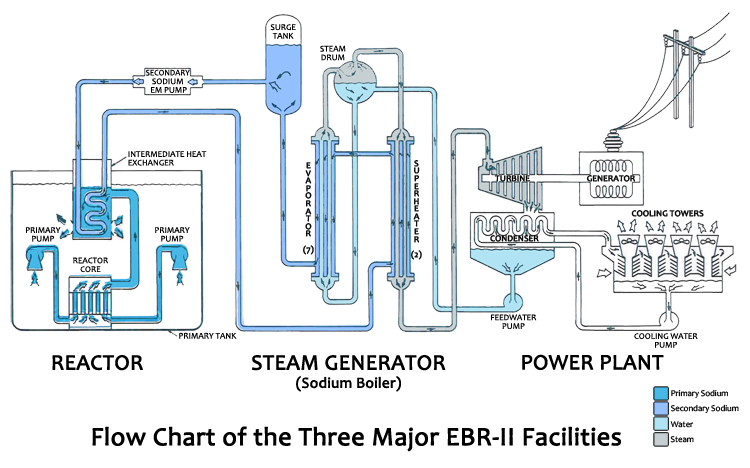FIPD: EBR-II Fuels Irradiation & Physics Database
FIPD is an organized collection of EBR-II test pin data and documentation. The database includes pin operation conditions calculated using a collection of ANL analysis codes developed during the IFR program, including axial distributions for power, temperatures, fluences, burnup, and isotopic densities. The database also contains pin measured data from post-irradiation examination, including pin fission gas release and gas chemistry measurements, and axial distributions from profilometry, gamma scans, and neutron radiography. There is also an extensive collection of documents associated with different pins and experiments, including raw PIE data, design descriptions, safety analysis, and operational reports.
The Experimental Breeder Reactor-II (EBR-II) was originally designed and operated with emphasis on demonstrating a complete breeder-reactor power plant with on-site reprocessing of metallic fuel. This was successfully done from 1964 to 1969. During that five years, the reactor's Fuel Cycle Facility processed 35,000 fuel elements, produced 366 subassemblies, and assembled 66 control and safety rods. The facility was then converted from a breeder to a burner reactor. The new missions emphasized testing fuels and materials for larger, liquid metal reactors.
Contents
FIPD Database Design
Experiment Description and Characterization
The database takes account of the variety of characterstics that were either calculated for, or directly measured from, EBR-II pins during the IFR program. FIPD contains calculated operating data, documentation, and select measured data for:
- 35 Experiments (64 Subassemblies)
- 2657 Pins
- 88 Runs
Access Restrictions
Technical information pertaining to the experiments has typically been described in limited-distribution experiment reports, conference proceedings, published journal articles, technical meeting transactions, calculated data. Because much of the content have US federally-imposed restrictions on their dissemination, access to different content in FIPD is determined on an individual basis.
Document Characterization
Individual documents in the database document collection are characterized in terms of the types of information they contain, as listed below.
- Analysis of data / observations 44
- Calculations (from simulation) 6
- Design / construction 55
- Drawing 22
- Fabrication Data 64
- Fuel description 33
- General planning & preparation 694
- Loading Diagram 126
- PIE planning 103
- Post-irradiation exam data 485
- Quality Assurance 108
- Run Information 61
- Run Report 37
- Safety 136
- Test specs 32
Post-irradiation examination (PIE) data and analysis is available for select pins, in either the original data document form, or as digitized numeric data. The PIE catagories are listed below:
- Bow measurements 27
- Contact profilometry 50
- Fuel redistribution 8
- Gamma scan 61
- Gas chemistry 21
- Gas release 44
- Irradiated length 24
- Irradiated weight 32
- Laser profilometry 26
- Metallography data 84
- Neutron radiography 38
- Other HFEF data 27
- S/A disassembly photos and/or information 35
- S/A profilometry data 14
- Strain data 3
- Swelling data 4
- Visual exam photos/data 29
EBR-II: The Experimental Breeder Reactor II

The Experimental Breeder Reactor-II (EBR-II) was originally designed and operated with emphasis on demonstrating a complete breeder-reactor power plant with on-site reprocessing of metallic fuel. This was successfully done from 1964 to 1969. During that five years, the reactor's Fuel Cycle Facility processed 35,000 fuel elements, produced 366 subassemblies, and assembled 66 control and safety rods. The facility was then converted from a breeder to a burner reactor. The new missions emphasized testing fuels and materials for larger, liquid metal reactors.
EBR-II was the backbone of the U.S. breeder reactor effort from 1964 to 1994, when research was terminated. The EBR-II accommodated as many as 65 experimental subassemblies at one time for irradiation and operational reliability tests. EBR-II also performed over 30,000 irradiation tests. Most recently, EBR-II was the prototype for the Integral Fast Reactor (IFR).
One feature new to the EBR-II was its pool-type design. Simply put, the reactor core, its fuel handling equipment, and many other systems of the reactor were submerged under molten sodium. This type of design had many benefits, including simplified design and construction, reduction of thermal stress, elimination of some heavily shielded external facilities, and, most importantly, increased safety.
The pool-type design, combined with its metal alloy fuel, made the EBR-II passively safe. That is, the reactor could safely shut down, without operator assistance, even if safety systems had failed. This safety feature was not dependent on control rods or computer monitoring, but on the laws of physics. This reliance on natural physical properties is the ultimate backup safety system for a nuclear power plant. This would make nuclear incidents, such as those that occured at Three Mile Island and Chernobyl, nearly impossible to duplicate. This was demonstrated in 1986, when EBR-II underwent a series of IFR safety tests. These tests simulated accidents involving loss of coolant flow. Even with the normal shutdown devices disabled, the reactor safely shut down without reaching excessive temperatures anywhere in the system.

Among the many long-term achievements of EBR-II are the following:
- The generation of over 2 billion kilowatt-hours of electricity
- The irradiation of over 30,000 specimens of fuel, structural, and absorber materials
- The in situ testing of advanced instrumentation concepts
- The Inherent Safety Demonstration Test on April 3, 1986
- The application of current computer technology for advanced diagnostics techniques and control

EBR-II stopped operations in 1994 when it lost federal funding. The tests and experiments that have been conducted in EBR-II have contributed heavily to national and international reactor technology, especially FBR (Fast Breeder Reactor) technology.
During a ceremony held December 14, 1995, EBR-II was declared a Nuclear Historic Landmark by the American Nuclear Society (ANS). According to ANS's executive director James Toscas, "EBR-II is arguably the most successful test reactor ever." He also called EBR-II "a research leader for the world," citing that many countries have copied its pool type design, with great success."
Ongoing Development
It is intended to continue expanding the FIPD database as additional calculations and quality assurance efforts are performed in the future.
FIPD was developed by the Nuclear Engineering Division of Argonne National Laboratory, USA. Argonne National Laboratory's work was supported by the U.S. Department of Energy, Assistant Secretary for Nuclear Energy, Office of Nuclear Energy, under contract DE-AC02-06CH11357.
Contributors to the FIPD development include Aaron Oaks, Walid Mohamed, Kun Mo, Abdellatif Yacout, Tanju Sofu, and Paul Froehle.